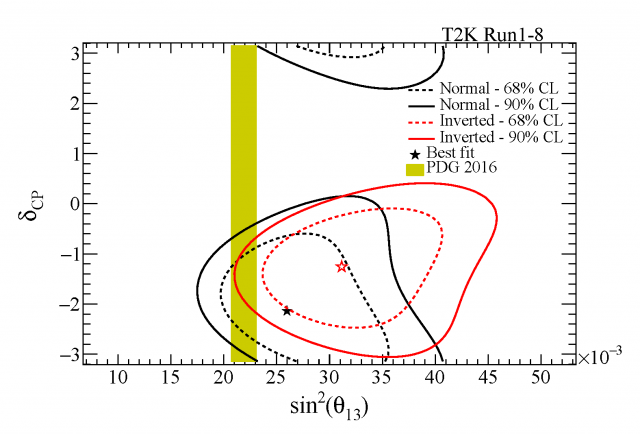Constraint on the matter–antimatter symmetry-violating phase in neutrino oscillations
The charge-conjugation and parity-reversal (CP) symmetry of fundamental particles is a symmetry between matter and antimatter. Violation of this CP symmetry was first observed in 19641, and CP violation in the weak interactions of quarks was soon established2. Sakharov proposed3 that CP violation is necessary to explain the observed imbalance of matter and antimatter abundance in the Universe. However, CP violation in quarks is too small to support this explanation. So far, CP violation has not been observed in non-quark elementary particle systems. It has been shown that CP violation in leptons could generate the matter–antimatter disparity through a process called leptogenesis4. Leptonic mixing, which appears in the standard model’s charged current interactions5,6, provides a potential source of CP violation through a complex phase δCP, which is required by some theoretical models of leptogenesis7,8,9. This CP violation can be measured in muon neutrino to electron neutrino oscillations and the corresponding antineutrino oscillations, which are experimentally accessible using accelerator-produced beams as established by the Tokai-to-Kamioka (T2K) and NOvA experiments10,11. Until now, the value of δCPhas not been substantially constrained by neutrino oscillation experiments. Here we report a measurement using long-baseline neutrino and antineutrino oscillations observed by the T2K experiment that shows a large increase in the neutrino oscillation probability, excluding values of δCP that result in a large increase in the observed antineutrino oscillation probability at three standard deviations (3σ). The 3σ confidence interval for δCP, which is cyclic and repeats every 2π, is [−3.41, −0.03] for the so-called normal mass ordering and [−2.54, −0.32] for the inverted mass ordering. Our results indicate CP violation in leptons and our method enables sensitive searches for matter–antimatter asymmetry in neutrino oscillations using accelerator-produced neutrino beams. Future measurements with larger datasets will test whether leptonic CP violation is larger than the CP violation in quarks.
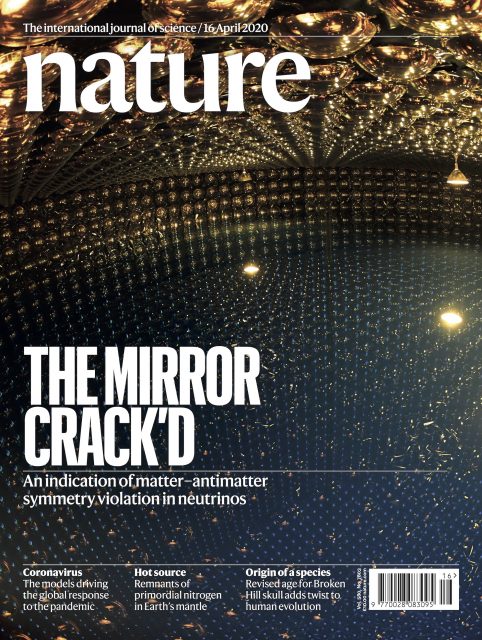
Measurement of the charged-current electron (anti-)neutrino inclusive cross-sections at the T2K off-axis near detector ND280
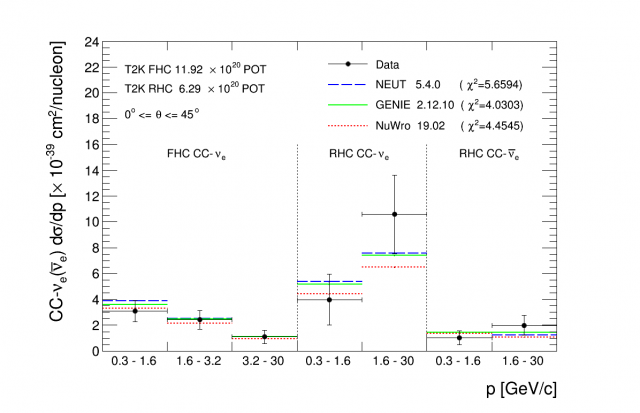
First combined measurement of the muon neutrino and antineutrino charged-current cross section without pions in the final state at T2K
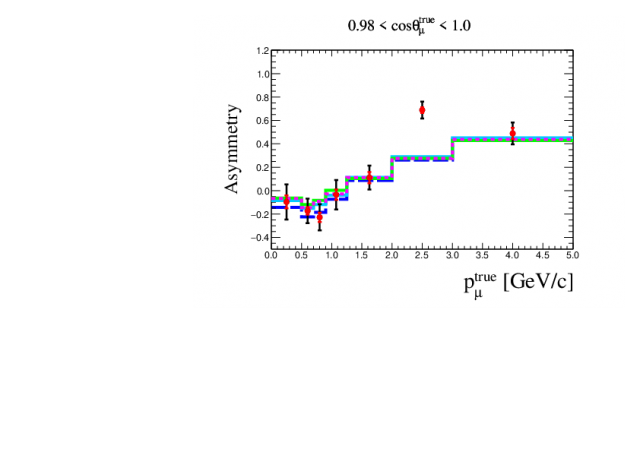
Measurement of the muon neutrino charged-current single $\pi^+$ production on hydrocarbon using the T2K off-axis near detector ND280

Measurement of neutrino- and antineutrino-oxygen neutral-current quasielastic-like interaction cross sections by detecting nuclear de-excitation gamma-rays at the far detector with Run1-9 FHC and RHC data
Neutrino- and antineutrino-oxygen neutral-current quasielasticlike interactions are measured at Super- Kamiokande using nuclear deexcitation γ rays to identify signal-like interactions in data from a 14.94(16.35) × 10^20 protons-on-target exposure of the T2K neutrino (antineutrino) beam. The measured flux-averaged cross sections on oxygen nuclei are 1.70 +- 0.17(stat)+-0.51(syst) × 10^-38 cm2/oxygen with a flux flux-averaged energy of 0.68 GeV, for neutrinos and antineutrinos, respectively. These results are the most precise to date, and the antineutrino result is the first cross section measurement of this channel. They are compared with various theoretical predictions. The impact on evaluation of backgrounds to searches for supernova relic neutrinos at present and future water Cherenkov detectors is also discussed.
Published in Phys.Rev. D100 (2019) no.11, 112009
DOI: 10.1103/PhysRevD.100.112009
e-Print: arXiv:1910.09439 [hep-ex]
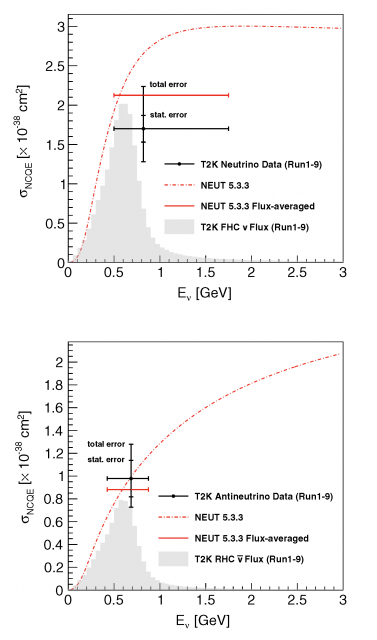
Measurement of the muon neutrino charged-current cross sections on water, hydrocarbon and iron, and their ratios, with the T2K on-axis detectors
σ^{H2O}_{CC}=(0.840±0.010(stat.)+0.10−0.08(syst.))×10−38cm2/nucleon, σ^{CH}_{CC}=(0.817±0.007(stat.)+0.11−0.08(syst.))×10−38cm2/nucleon, and σ^{Fe}_CC=(0.859±0.003(stat.)+0.12−0.10(syst.))×10−38cm2/nucleon,
respectively, for a restricted phase space of induced muons: θμ<45∘ and pμ>0.4 GeV/c in the laboratory frame. The measured cross section ratios are σ^{H2O}_{CC}/σ^{CH}_CC=1.028±0.016(stat.)±0.053(syst.), σ^{Fe}_{CC}/σ^{H2O}_{CC}=1.023±0.012(stat.)±0.058(syst.), and σ^{Fe}_{CC}/σ^{CH}_{CC}=1.049±0.010(stat.)±0.043(syst.). These results, with an unprecedented precision for the measurements of neutrino cross sections on water in the studied energy region, show good agreement with the current neutrino interaction models used in the T2K oscillation analyses.
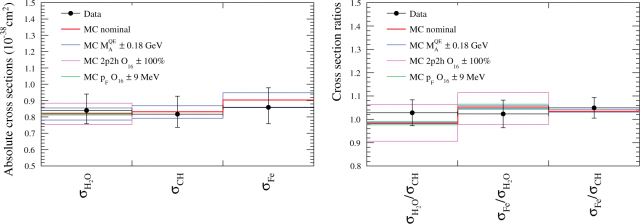
Search for neutral-current induced single photon production at the ND280 near detector in T2K
DOI: https://dx.doi.org/10.1088/1361-6471/ab227d
ArXiv: https://arxiv.org/abs/1902.03848
Physics World: https://physicsworld.com/a/t2k-searches-for-single-gamma-rays-from-neutrino-interactions
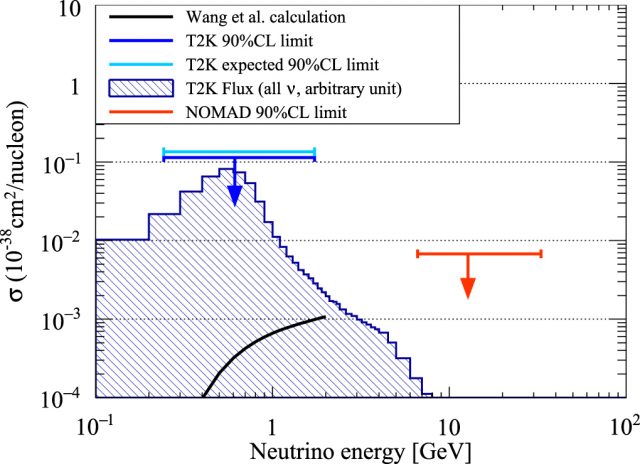
Search for light sterile neutrinos with the T2K far detector Super-Kamiokande at a baseline of 295 km
link to publication : https://journals.aps.org/prd/abstract/10.1103/PhysRevD.99.071103
There is a data release for this paper here

Search for heavy neutrinos with ND280
This paper (Phys. Rev. D 100, 052006 (2019)) reports on the search for heavy neutrinos with masses in the range 140 < MN <493 MeV/c2 using the off-axis near detector ND280 of the T2K experiment. These particles can be produced from kaon decays in the standard neutrino beam and then subsequently decay in ND280. The decay modes under consideration are N→l_α π and N→l_α l_β ν (α,β=e,μ). A search for such events has been made using the Time Projection Chambers of ND280, where the background has been reduced to less that 2 events in the current dataset in all channels. No excess has been observed in the signal region. A combined Bayesian statistical approach has been applied to extract upper limits on the mixing elements of heavy neutrinos to electron-, muon- and tau- flavoured currents (Ue2, Uμ2, Uτ2) as a function of the heavy neutrino mass, e.g. Ue2 < 10^(−9) at 90% C.L. for a mass of 390MeV/c2. These constraints are competitive with previous experiments.
There is a data release for this paper here.
Search for CP violation in Neutrino and Antineutrino Oscillations by the T2K experiment with 2.2E21 protons on target
The T2K experiment measures muon neutrino disappearance and electron neutrino appearance in accelerator-produced neutrino and antineutrino beams. With an exposure of 14.7(7.6)×1020 protons on target in (anti)neutrino mode, 89 electron neutrino candidates and 7 electron antineutrino candidates were observed while 67.5 and9.0 are expected for δCP=0 and normal mass ordering. The obtained 2σ confidence interval for the CP violating phase, δCP , does not include the CP-conserving cases (δCP=0, π). The best-fit values of other parameters are sin^2_θ23 = 0.526+0.032 −0.036 and ∆m^2_32 = 2.463 ± 0.065E−3 eV2/c4 .
Published in Phys.Rev.Lett. 121 (2018) no.17, 171802
DOI: 10.1103/PhysRevLett.121.171802
